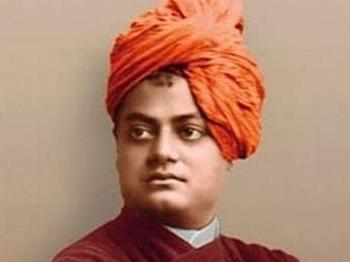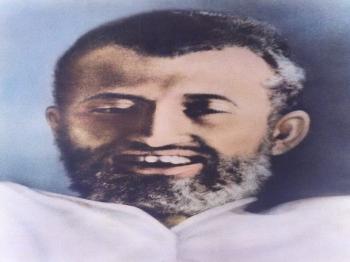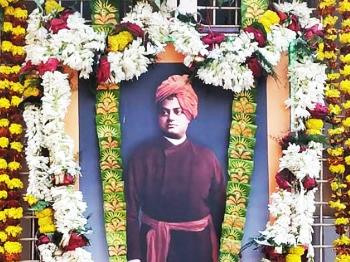Life and Teachings of Swami Vivekananda
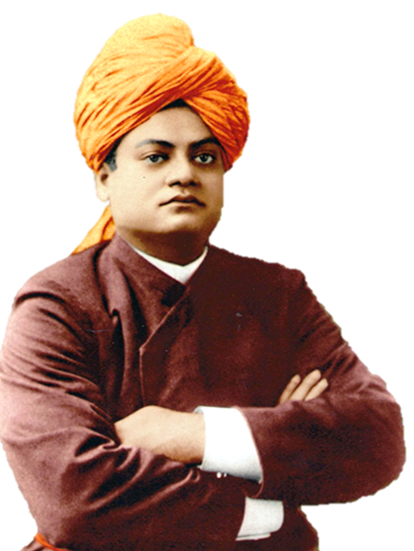
Birth, childhood and student days
Swami Vivekananda was one of the pioneers of India’s nineteenth-century revival. Many thinkers have called him the builder of modern India. He inspired the people of not only India but of the entire world with the mantra of self-faith, by declaring on the basis of India’s age-old spiritual wisdom, the inherent divinity of man. He carried the messages of ‘As many faiths, so many paths’ and ‘Service of all beings looking upon them as God’, which he learnt from his teacher Sri Ramakrishna to all men of all times, transcending the limits of time and place. The birth of Vivekananda at 6.33 a.m., just six minutes before sunrise, on January 12, 1863, which was the 7-the day of the dark fortnight of the lunar month and auspicious because it was the day of Makara Sankranti, marked, as it were, a new sunrise in the history of India. He was born in the Simla locality of Calcutta, the then capital of British India, as the eldest son of Bishwanath Datta and Bhubaneswari Devi. His father Bishwanath Datta, who was by profession an attorney, was proficient in seven languages and keenly interested in history and music. His mother too was spirited and at the same time devout, kindhearted and educationally advanced. As Bhubaneswari Devi got her son by praying to Vireswar Siva of Kashi, she gave him the name Vireswar (nickname was Bile) – his formal name was Narendranath, with its shorter form Naren. The arrangement for the comprehensive growth of a child in the aristocratic, liberal-minded Datta family was nice. From the early days, the child was encouraged to develop his interest in studies, sports, exercise, poetry, music, and above all, to develop the capacity for independent thinking. Right from his childhood, Narendranath exhibited sympathy towards others, an inclination for logical reasoning, uncommon courage, self-confidence, and those natural leadership qualities. Once to save his companion from being crushed by a horse-drawn carriage, he jumped forward without any consideration of his own danger. Again, without being afraid, he approached and explained to the British soldiers in English that his friends have been detained in the boat by the boatmen. With their help, he arranged for his friends to come ashore. Wanting to see the man-of-war Syrapis, he was thwarted in his attempt to get permission from the official in charge by the latter’s gateman who thought him to be too young. He sidetracked the difficulty by reaching the official by the staircase at the back and procured permission. Along with this, he had a natural attraction towards spirituality. In his early childhood, if at any time he was unmanageably naughty, he would become quiet in a moment if somebody poured water on his head saying ‘Siva, Siva’. When going to bed, before falling asleep, he would regularly see between his two eyebrows a luminous spot that would gradually expand and make the surroundings illumined.
In 1871 Narendranath was admitted to the ninth class (at present Class II) in Iswar Chandra Vidyasagar’s Metropolitan Institution. One could get an inkling of the uncommon radiance of his genius even from those boyhood days. He was the centre of attraction in debating groups and discussion sessions in the school. In games and sports, he was the leader. He showed great enthusiasm for stick-fighting, fencing, horse-riding, boat-rowing, swimming, wrestling and gymnastics. He joined the gymnasium of Naba Gopal Mitra and also set up his own gymnasium in the house. He became champion in the boxing competition and secured a silver butterfly as a prize. He organized an amateur theatre club, turned out to be a skilful actor and gained expertise in classical and devotional music.
In 1879 he passed the Entrance Examination in the first division and was admitted to Presidency College. At the end of the first year, he contracted malaria and remained bed-ridden for a long period. After that, he got admitted to General Assembly’s Institution (at present the Scottish Church College), and in 1881, after passing the F.A. (First Arts) Examination from that college, continued his studies there for graduation.
Association with Sri Ramakrishna
While studying at the college, Narendranath was exposed to Western agnostic philosophy, and as a result, was greatly troubled by the question ‘Does God exist, and if so, how can one know Him?’ In search of an answer to this question, he became a member of the Brahmo Samaj and was on the lookout for a person who had known God. At this time, he heard about the Samadhi of Sri Ramakrishna from William Hastie, the Principal of the College and in November 1881 met Sri Ramakrishna for the first time in the house of Surendra Mitra. The young man Narendranath, educated in the Western way, came to the Eastern sage Sri Ramakrishna who had reached perfection by undergoing the spiritual discipline of many religions, with a tremendous urge to resolve his doubts and problems of life and to search God. As soon as Sri Ramakrishna saw Narendranath, he identified him as his future principal messenger. Narendranath too found in Sri Ramakrishna someone who had experienced God directly. During the next few years, the tremendous attraction of Sri Ramakrishna’s unearthly love drew Naren to his company again and again. Sri Ramkrishna, the preceptor, engaged himself in carefully making Naren ready for his task. He wanted especially that his future messenger would be able to accord sincere recognition to all kinds of spiritual disciplines. At this time, due to the grace of Sri Ramakrishna, Naren had an experience that swept away like a piece of straw his objection to acceding to the presence of God as Consciousness in everything in this world. But Naren’s Brahmo background had created in his mind a strong antipathy against the worship of God with form, particularly against accepting Mother Kali. That antipathy was uprooted totally in the wake of a mishap in his family. On February 25, 1884, all of a sudden Naren’s father passed away. The scion of an aristocratic family, who had been so long brought up under fond care, fell into a dire financial crisis. It became difficult for Naren to provide sustenance to his mother and younger brothers. Commanded by Sri Ramakrishna to pray before the image of Mother Kali for the resolution of his financial crisis, Naren could not ask for money from her even after three attempts. He saw in the image of Kali Consciousness embodied in the form of the Mother of the universe – the fountain-head of infinite love and beauty. He lost himself and prayed for discrimination, dispassion, knowledge and devotion. After this, Naren somehow managed the financial needs of his family by working in an attorney’s office and translating books, but his mind henceforth remained riveted to the feet of Sri Ramakrishna even more than before.
Sometime after this Sri Ramakrishna contracted cancer of the throat. For the convenience of treatment, he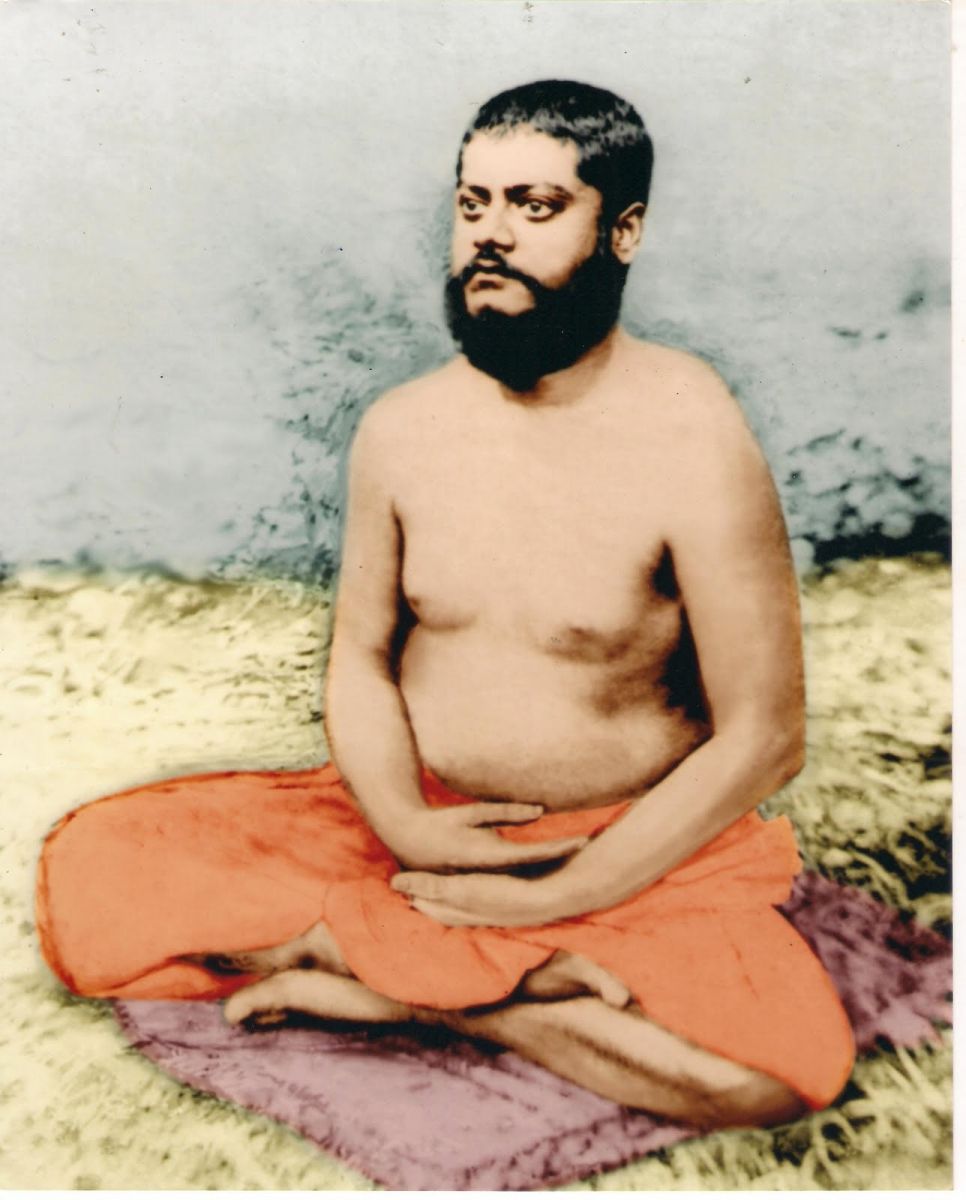 was brought to and kept at Kashipur Udyanbati. It was there, possibly on 9 January 1886, that Sri Ramakrishna handed over to each of his eleven world-renouncing disciples including Narendranath a piece of ochre cloth and a rosary of rudraksha beads that had been brought by the elder Gopal. He said, “These young servants of mine are each a hāzāri sadhu – equivalent to a thousand monks”. Marking Narendranath as the future teacher of mankind, he wrote a certificate – “Naren would teach”. Narendranath attained Nirvikalpa Samadhi in the right-hand room on the ground floor of that house. After this, although Naren was eager to remain immersed in Samadhi day and night, Sri Ramakrishna firmly implanted in his mind the idea that to alleviate the distress and open up the road to the liberation of those who are ailing and suffering is a much greater ideal.
was brought to and kept at Kashipur Udyanbati. It was there, possibly on 9 January 1886, that Sri Ramakrishna handed over to each of his eleven world-renouncing disciples including Narendranath a piece of ochre cloth and a rosary of rudraksha beads that had been brought by the elder Gopal. He said, “These young servants of mine are each a hāzāri sadhu – equivalent to a thousand monks”. Marking Narendranath as the future teacher of mankind, he wrote a certificate – “Naren would teach”. Narendranath attained Nirvikalpa Samadhi in the right-hand room on the ground floor of that house. After this, although Naren was eager to remain immersed in Samadhi day and night, Sri Ramakrishna firmly implanted in his mind the idea that to alleviate the distress and open up the road to the liberation of those who are ailing and suffering is a much greater ideal.
After the demise of Sri Ramakrishna on August 16, 1886, Narendranath with his brother-disciples established the first Ramakrishna Math in an old dilapidated house of Baranagore. In the third week of January 1887, at Baranagore Math, Narendranath and some of his brother-disciples formally took the monastic vow after performing the Viraja sacrifice. At that time, he took the monastic name ‘Vividishananda’. Later after changing his name many times, he settled with the name ‘Swami Vivekananda’; however, he became more well-known by the name ‘Swamiji’. In spite of extreme poverty, the newly ordained monks remained immersed in deep spiritual practice and studies.
Traveller
At this time an intense mental conflict made Swamiji restless. On the one hand, the desire to observe spiritual austerity in the Himalayas or some other secluded place was strong in his mind; on the other, he couldn’t make up his mind about how he would actualize the charge that his Guru had devolved on him. Not counting a few nearby places where he went for the sake of change, he more or less remained at Baranagore Math until the middle of 1888. In August 1888, he once went to Kashi for some days. After a short period following that, he went out again to travel to various pilgrim centres and other notable places of North India, such as Kashi-Ayodhya-Lucknow-Agra-Vrindavan-Haridwar-Hrishikesh and came back to the Math via Hathras. In this way, his mind expanded through contact with various places, views and persons. But every time he resolved to perform austerities by going to some secluded place, obstacles of various kinds hindered him. Towards the end of December. 1989, Swamiji went to Gazipur via Baidyanath Dham and other places and coming into contact with Pavhari Baba, thought about learning Raja-Yoga from him. But he went back on that programme after seeing the figure of Sri Ramakrishna in the night preceding the day on which he was to accept the discipleship of Pavhari Baba. On April 13, 1890, Balaram Bose, the devoted householder disciple of Sri Ramakrishna, passed away. After getting that news, Swamiji returned to Kolkata again.
After this, on August 3 of that year, Swamiji took the blessing of Holy Mother Sarada Devi and accompanied by Swami Akhandananda left Kolkata to travel in the Himalayas. They went towards Garhwal via Bhagalpur-Baidyanath-Gazipur-Kashi-Ayodhya-Nainital and Almora. But as one by one both of them fell ill, they had to come down to the plains dropping the plan of travelling in the Himalayas. They came to Meerut via Dehradun and Hrishikesh. As some other brother-disciples from various places came to join them, they together passed their days happily. But gradually this thought took a firm hold on Swamiji’s mind that to gain the experience he had to travel through India alone instead of remaining mutually dependent on others. With this objective in mind, he left Meerut by himself and proceeded towards Rajputana via Delhi. Then travelling through Western India, he came to South India at the end. Through this long sojourn, the traveller monk of India came into direct contact with the lives of the Indian masses. He felt the throb of India’s life concealed in the huts of the poor. He could hark the music of the mainstream of spirituality that flowed underneath. He upheld the principal message of Sanātana Dharma before all sections of people. Many a king, scholar and leader of society became enchanted and overwhelmed by his personality, genius and purity. During his sojourn in South India, towards the end of 1892, he reached Kanya Kumari from Trivandrum. There, at the southernmost tip of India, as he meditated sitting on a big rock situated in the sea at some distance from the coast, a climactic moment of his life appeared. He realized that to fulfill the task that Sri Ramakrishna had devolved upon him he would have to arouse the oppressed masses of the country. For that, he would have to organize the monks and idealistic educated youths to form an association. The members of this association would through service inspire the masses to overcome their inertia, meet their worldly needs, and along with that realize true religion in their lives. Swamiji decided that to collect the funds required for actualizing this plan he would go abroad and would appease the spiritual hunger of the people thereby preaching the Vedantic religion. He would thus earn their sympathy and co-operation. After being thus certain about his own plan of action, Swamiji came to Madras from Kanya Kumari. By that time arrangements were afoot to hold in 1893 a Parliament of Religions in Chicago city of America on a big scale. Distinguished people from different strata of society who were admirers of Swamiji, especially a few idealists young men of South India, requested him to participate in the Parliament of Religions as a representative of Sanatana Dharma. To know what he should do about this, he wrote to Holy Mother Sri Sarada Devi praying for her directions. As Holy Mother whole-heartedly gave her approval to the plan, he did not have any further qualms about going abroad to preach religion. So long he had been introducing himself at different places by different names such as ‘Vividishananda’, ‘Vivekananda’, ‘Sachchidananda’ etc. Henceforth the name ‘Vivekananda’ represented his permanent identity.
Abroad
On 31 May 1893, Swami Vivekananda sailed for America on board the Peninsular from Bombay harbour. He went via Colombo-Malaya- Singapore-Hong Kong to Kobe where he disembarked to travel by land through Japan to see some cities of that country. Then from Yokohoma harbour, he started for Vancouver onboard the Empress of India. After reaching Vancouver he went by train from there to Chicago. The initial unfamiliarity and hurdles passed off, as if by Divine dispensation, after he became acquainted with Professor John Henry Wright of Harvard University. Professor Wright, impressed by the sun-like brilliance of Swamiji’s scholarship, wrote with a special request to Dr Barrows, the Chairman of the General Committee of the Parliament of Religions and created for him the opportunity to participate in the Parliament in a way that was never thought of. In the Parliament, which began on September 11, Swamiji delivered six lectures. In the first lecture, his address of the audience in the words ‘Sisters and Brothers of America’, carried away the entire house in a terrific tide of emotions and congratulations. Evidence of how the American citizens were influenced and overwhelmed by his personality and scholarship, is scattered in the pages of contemporary newspapers and magazines and the reminiscences of his distinguished admirers.
After the Parliament of Religions ended, Swamiji did lecture tours in different cities of America continuously for more than one and a half years and preached the Vedanta religion. In spite of the stiff opposition of a class of Christian priests and self-seeking persons, he earned tremendous popularity. After this, to place the work begun in America on a firm foundation, from June 18 to August 6, 1895, he trained twelve devout followers and gave them lessons in the deeper intricacies of spiritual practice in Thousand Island Park, situated in a secluded island on the river St. Lawrence near the northern border of USA. After returning from there he went to Europe in the company of an American friend and preached Vedanta in London for about three months. While in England, apart from giving lectures, he took quite a number of classes to teach some ardent students. In this way, a group of his admirers came to be formed in London too. Miss Margaret Noble (later Sister Nivedita) was a prominent member of this group. Swamiji ended this short visit to England and returned to New York on December 6, 1895. For the next four and a half months, first in New York and thereafter in different places such as Detroit, Boston, Chicago etc. he gave many lectures and took countless classes. On the basis of the shorthand records of the lectures given during this period, came out his four books on Yoga such as Karma-Yoga, Raja-Yoga etc. Besides at this time, Swamiji organized the Association named Vedanta Society of New York. After consolidating the work of propagating Vedanta in America on a firm foundation in this way, on April 15, 1896, he sailed again for London. This time, first from April to July and later from September to December, in all for six months, he tirelessly took classes and gave public lectures to arouse in the educated class of England an interest in the religion and culture of India, especially in the Vedantic religion. (In between for two months he toured France-Switzerland- Italy-Germany-Holland and other countries with some of his followers.) A sizeable number of distinguished people from the West became his admirers – some among these accepted his discipleship and devoted themselves to his work. It was at this time that an intimate friendship developed between him and two renowned savants – Professor Max Müller of Oxford and Professor Paul Deussen of Kiel. Before leaving England, Swamiji brought two of his brother disciples – Swami Saradananda and Swami Abhedananda–from India and entrusted the responsibility of the work in England and America respectively in their hands. After successfully propagating Vedanta in the West in this way, Swamiji left England on December 16 to sail for India from Naples harbour of Italy on December 30.
Return to India and Establishment of the Ramakrishna Mission
Swamiji reached Colombo on 15 January 1897. His unthought-of success in the West aroused the self-respect of the subordinated nation. The people of the country received him with a historic and spontaneous mass welcome. However, due to excessive toil and the strain of reception, his ailing body became even more ill. Through the lectures he gave in response to the receptions, Swamiji pointed out the direction in which a new India should be reconstructed and once more sprinkled on the psyche of the country the resuscitating nectar of the eternal religion. Some months after his arrival, on May 1, 1897, he formally established the Ramakrishna Mission. This Mission upholds the ideal of promoting the spiritual progress of aspirants by doing good to the world through service-oriented work. But because many of the brother-disciples of Swamiji were unsure about how far this ideal was consistent with the teachings of Sri Ramakrishna, he had to do some struggle to convince them. However, gradually all of them accepted the ideal whole-heartedly. Following his instruction, at this time Swami Ramakrishnananda went to Madras taking upon himself the responsibility of preaching in South India and established a new centre of the Math there. Swami Akhandananda opened a centre for serving the people in the famine-stricken area of Murshidabad. As Swamiji’s broken health broke down further by the strain of introducing all these schemes of work, to regain his health he had to go first to Darjeeling and later to the Almora region. But he had no respite from work. From Almora, he again set out for a tour of North India. Taking some brother-disciples and some of his own disciples, both male and female, with him, he travelled through Almora-Bareilly-Ambala-Amritsar-Srinagar-Rawalpindi-Lahore-Dehradun-Alwar-Khetri and at each place preached how the reawakening of India can be brought about through her spiritual rejuvenation. But as his health broke down due to excessive exertion, he had to cut short his lecture tour and return to Calcutta on January 15, 1898. At this time the Math was transferred to Belur and Belur Math’s own land was also purchased. There, under Swamiji’s careful supervision, the training of the new Brahmacharins went on. Miss Margaret Noble or Sister Nivedita and some other Western disciples and admirers of Swamiji came to India at this time and started living at Belur itself. Swamiji began to train them; especially he began to prepare Nivedita for taking up the work of propagation of women’s education in India. In the midst of this, he went to Darjeeling for a month to take a rest. But as plague broke out in Calcutta in an epidemic form and caused panic among the masses, he came back to engage Ramakrishna Mission in relief work. After this Swamiji with his Western women disciples set out again for a tour of places adjacent to the Himalayas and after visiting Almora-Kashmir-Amarnath- KshirBhavani returned to Calcutta on October 18. A few weeks after that, inspired by Swamiji, Sister Nivedita started at Baghbazar a school for the education of Indian girls. In the same year, Swamiji founded the Ramakrishna Math on its own land at Belur and chalked out the future plan of work of the Order – Bahu-jana- hitāya bahu-jana-sukhāya (For the benefit of the many, for the happiness of the many) and Atmano mokshārtham jagadhitāya ca (For one’s own liberation and the good of the world).
In 1899, around the middle of January, under the direction of Swamiji and the editorship of Swami Trigunatitananda, publication of Udbodhon, the Bengali mouthpiece of the Math and the Mission started. On 19 March under Swamiji’s inspiration, his English disciples Captain and Mrs Sevier established at Mayavati in a secluded region of the Himalayas, the Advaita Ashrama as a centre for non-dualistic spiritual practice. Prabuddha Bharata, the English mouthpiece of the Math and the Mission started being published from there.
After this to infuse new life in the work of the West, Swamiji set out for the West again taking Nivedita and Swami Turiyananda with him. In spite of his illness, to popularize Udbodhan, during the long journey he wrote for that journal a travelogue which has remained forever an invaluable treasure of Bengali literature. This time after reaching America via England, he made the California region on the West Coast of that country, the principal field of his activity. He stayed there for several months and delivered quite a number of lectures. Further, for preaching Vedanta in the West Coast region he set up a centre and before leaving America, entrusted its charge to Swami Turiyananda. In the year 1900, towards the end of July, he left America for France and participated in the Congress of the History of Religions that was held in Paris. In the second half of October, he left Paris and travelled through Eastern Europe via Vienna-Constantinople-Athens and finally Egypt to return to Belur Math on December 9, 1900. In the meantime, his disciple Captain Sevier, the founder of the Advaita Ashrama at Mayavati, had passed away. So immediately after this, to make arrangements for the management of that centre he had to go there braving the hardship of a difficult road journey in the midst of severe winter cold. His health broke down totally at that time. In spite of that, after this, he left the Math twice and went once to Dhaka, Kamakhya and Shillong and the second time to Bodh Gaya and Kashi. On Friday, the 4 July 1902 at 9.10 p.m. He passed into Mahasamadhi in his own room at Belur Math.
Innumerable persons in different corners of the world remain devoted to various activities for the good of mankind, keeping the life, message and ideal of Swami Vivekananda before them. He himself wrote – you work unto death; I would remain with you, and even after my body would be no more, my energy would continue to work with you.
Brief chronology of the main events of Swamiji’s life
1863, January 12, the seventh day of the dark fortnight by the lunar calendar in the month of Poush, the day of the Makara Samkranti, six minutes before sunrise (6.33 a.m.) – Was born.
1871– Was admitted to the ninth class (present Class II) in Metropolitan Institution of Iswar Chandra Vidyasagar.
1879 – After passing the Entrance Examination in the first division, got admitted to Presidency College. At the end of the first year, after remaining bedridden for many days being stricken by malaria, got admitted to the General Assembly’s Institution (the present Scottish Church College).
1881 – Passed the F.A. (First Arts) Examination from General Assembly’s Institution. The same year in November met Sri Ramakrishna for the first time in the house of Surendra Mitra. Came to Sri Ramakrishna at the Kali Temple at Dakshineswar for the first time in December.
1884 – His father passed away at night on February 25.
1886 – Possibly on January 9, at Kashipur Udyanbati Sri Ramakrishna handed ochre clothes and rosaries of rudraksha to Narendra Nath and ten other disciples, who renounced the world. In the last week of March, in the room on the right on the ground floor of Udyanbati, Narendra Nath entered into nirvikalpa Samadhi. On August 16, Sri Ramakrishna passed into Mahasamadhi.
1887, the third week of January – At Baranagar Math Narendra Nath and a few of his brother disciples embraced formal Sannyasa after performing the Viraja sacrifice. Narendra Nath assumed the monastic name Vividishananda.
1888 – Narendra Nath visited Kashi; then going out again he made a tour of Kashi-Ayodhya-Lucknow-Agra- Vrindavan-Hardwar-Hrishikesh in Northern India and returned to Baranagore Math towards the end of the year.
1889 – Towards the end of December went to Vaidyanath Dham and from there to Allahabad, Ghazipur and Kashi.
1890, April 13 – Got the news of Balaram Babu’s passing away and returned to Calcutta. Then again on August 3, left Calcutta to go via Bhagalpur-Vaidyanath-Ghazipur-Kashi-Ayodhya-Nainital-Almora-Meerut-Delhi towards Rajputana and from there through Western India to South India.
1892, December (possibly 24-26) – At Kanyakumari, sitting on a big piece of rock in the sea, meditated and decided on his future course of action.
1893, May 31– From Bombay started for America on board the Peninsular. Went via Colombo-Malaya-Singapore-Hongkong and disembarked at Kobe to visit some cities of Japan by land. Then from Yokohama harbour of Japan sailed for Vancouver of Canada on board the Empress of India. From Vancouver reached Chicago by train. At the Parliament of Religions, which started on September 11, Swamiji delivered six lectures.
1895, from June 18 to August 6 – Swamiji taught the deeper intricacies of spiritual practice to twelve of his disciples at thousand islands park. On August 17 left for a short trip to Europe. After visiting Paris and London returned to New York on December 6.
1896 –After giving lectures in different places of America for four and a half months and organizing the Vedanta Society of New York, he sailed for London again on April 15. He delivered lectures and took regular classes at different places in London from April to July and again from September to December. In between, for about one and a half months, he went to Europe and toured in France-Switzerland-Italy-Germany-Holland. On December 16 visited Milan-Pisa-Rome by train and reached Naples. From there he sailed for India on December 30.
1897, January 15 – Swamiji arrived at Colombo. The people received him with a historical and spontaneous mass welcome. Through the lectures delivered by him in reply to the receptions at different places, Swamiji pointed out the direction in which a new India should be reconstructed.
1897, May 1 – He formally founded the Ramakrishna Mission.
1898, January 15 – Returned to Calcutta, after making a tour of Almora-Bareilly- Ambala-Amritasar-Srinagar-Rawalpindi-Lahore-Dehradun-Alwar-Khetri.
1898, March 30 – Went to Darjeeling to take rest, but after one month when news came of the outbreak of a plague epidemic in Calcutta, returned to organize relief work there.
1898, May 11 – Started once again to visit Almora-Kashmir-Amarnath- Kshir Bhavani and returned to Calcutta on October 18. A few weeks after that a school for the education of Indian girls was started at Baghbazar by Sister Nivedita under Swamiji’s inspiration. The same year on December 9 Swamiji established Sri Ramakrishna Math at Belur and chalked out the future plan of work of the Order – Bahu-jana- hitāya bahu-jana-sukhāya (For the benefit of the many, for the happiness of the many) and Atmano mokshārtham jagadhitāya ca (For one’s own liberation and the good of the world).
1899, January – Under Swamiji’s inspiration the journal Udbodhan started its publication. On March 19, at Mayavati Captain Sevier founded the Advaita Ashrama as conceived and planned by Swamiji.
1899, June 20 – Swamiji started for the West a second time and reached America after visiting England. This time through about one year he preached Vedanta in America, particularly in the California region on the West Coast, by delivering a large number of lectures.
1900 –Towards the end of July he left America and after visiting Paris-Vienna- Constantinople-Athens-Egypt returned to Belur Math on December 9. After this, in spite of his broken health, he visited Mayavati, East Bengal and Assam, and Bodh Gaya and Kashi to attend to the call of various pressing necessities.
1902, July 4, Friday, at 9.10 p.m. – Swamiji passed into Mahasamadhi in his own room at Belur Math.
Immortal sayings
Love, truth, and unselfishness… form our highest ideal, because in them lies such a manifestation of power.

